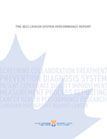Measuring the performance of cancer control to maximize impact
Partnership releases 2011 Cancer System Performance Report
January 26, 2012
 Measuring the performance of the cancer system provides information that will inform initiatives to optimize quality in cancer control. The Partnership’s System Performance Initiative is a collaboration with national and provincial partners to develop a consistent approach to evaluate, compare and identify key areas for action across Canada’s cancer control continuum. As part of this initiative, the Partnership is pleased to release the 2011 Cancer System Performance Report, an annual publication that helps shape this work.
Measuring the performance of the cancer system provides information that will inform initiatives to optimize quality in cancer control. The Partnership’s System Performance Initiative is a collaboration with national and provincial partners to develop a consistent approach to evaluate, compare and identify key areas for action across Canada’s cancer control continuum. As part of this initiative, the Partnership is pleased to release the 2011 Cancer System Performance Report, an annual publication that helps shape this work.
The System Performance Initiative collects data from several sources, including provincial cancer agencies, Statistics Canada, and other partners, including more recently the Canadian Institute for Health Information, to measure progress in cancer control across the country. This information provides insight on the current status of key indicators across the cancer control continuum, from prevention, screening and diagnosis to treatment, supportive care and survivorship. The System Performance Reports are used by the cancer control community to identify gaps in measurement capabilities and in actual performance. This process can help health planners to identify opportunities for improvement that may not have been revealed without these pan-Canadian comparisons and analyses.
The 2011 Cancer System Performance Report builds on the first two reports (published in 2009 and 2010) by updating a number of indicators with more recent data and introducing several new ones for areas including prevention, screening, treatment and long-term outcomes. As this is the third report, the availability of additional years of data makes it possible to begin to identify trends for several of the indicators, particularly in treatment.
Dr. Heather Bryant, the Partnership’s Vice-President of Cancer Control, who also oversees the System Performance Initiative, notes that the reports are designed to encourage discussion and develop priorities for action within Canada’s cancer control and health-care system: “Each year’s report identifies new questions that need to be asked and underlines the importance of measuring and reporting on cancer control efforts across the country.”
To make the report easy to use, the information for each indicator uses the same format: what is being measured, why it is being measured, what the results show, what is happening internationally, what is being done and what the reader needs to be aware of regarding the data and measurement.
Some highlights of the 2011 report include:
- In Prevention, new indicators have been added for rates of smoking prevalence, cessation and second-hand smoke exposure; alcohol consumption and alcohol abstinence; fruit and vegetable consumption; physical activity; and adult and adolescent obesity. The performance data on smoking indicate falling smoking rates and decreasing second-hand smoke exposure, which are both positive findings. On the other hand, alcohol consumption has increased and the percentage of Canadians considered overweight or obese continues to rise, even though physical activity and fruit and vegetable consumption are improving.
- In Screening, new indicators have been added for HPV vaccination. Available data show variation in uptake among provinces, though participation rates for Pap tests were reasonably consistent across provinces. Participation rates for colorectal cancer screening continue to vary substantially by province, reflecting differences in the when each of the provincial programs started.
- In Diagnosis, the percentage of incident cases for which stage data are available in the provincial cancer registries continues to increase, with six of nine reporting provinces at or above 90% for the top four cancer sites (breast, prostate, colorectal and lung). Wait times from positive mammogram to diagnosis resolution in breast cancer still vary substantially among provinces.
- In Treatment, an additional year of data was added in this year’s Report, allowing for preliminary trend analysis for the indicators measuring treatment rates relative to evidence-based guidelines. For radiation therapy wait times, seven of ten provinces had achieved the target of 90% of patients starting radiation therapy within four weeks of being ready to treat.
As in previous reports, the performance results are compared, where appropriate, by province or territory, age and sex, geography (urban, rural or remote) and socio-economic status (measured by income and/or education). In addition, the 2011 report examines new relationships for these areas, including relative survival rates by income, and conditional survival. Relative survival compares the likelihood of someone with cancer surviving for five years with the likelihood of survival for the general population. Conditional survival measures the likelihood of someone with cancer surviving an additional specified number of years, given that they have already survived a certain number of years after cancer diagnosis.
“Although each province and territory collects this data to see their individual progress and where to focus improvements, the need for national collaboration must not be understated,” says Dr. Terry Sullivan, who chairs the Partnership’s System Performance and Quality Initiative Advisory Council. “This set of pan-Canadian indicators is an excellent resource to help provinces set priorities and help guide better decision-making, which will in turn drive quality and improvement in the cancer system as a whole.”
As this initiative moves forward, the Partnership will continue to work with the provinces to build on existing information resources and to provide reports that provide meaningful measurement of the performance of Canada’s cancer control system.
